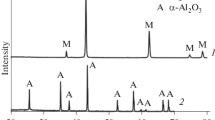Conclusions
During the sintering process of beta-alumina obtained using the method of plasmochemical synthesis, the β″ → β structural transformation occurs and it is accompanied by the separation of the excess Na2O and the formation of an intergranular meltlike phase that is saturated with sodium and is characterized by high dielectric properties.
The quantity of the meltlike phase and the magnitude of the β″/(β″ + β) ratio determine the degree of stabilization (stability) and the final resistivity of the material and depend on the initial chemical composition and the heating rate maintained during the sintering process.
It was shown that when the duration of residence of the material in the hot zone of the furnace is increased or when the specimens sintered maintaining high heating rates are subjected to additional heat treatment, one observes the occurrance of the β → β″ reverse structural transformation that is characterized by an increase of the phase ratio β″/(β″ + β) → 1, a reduction in the quantity of the meltlike phase right up to its complete disappearance, and a decrease of the electrical resistivity of the material.
In the materials having a large excess quantity of sodium oxide, the process of crystallization of the intergranular NaAlO2 phase occurs simultaneously with the second β → β″ phase transformation.
The best ceramic and electrophysical parameters were obtained when sintering the material contained 7.9% Na2O.
Similar content being viewed by others
Literature cited
R. Stevens and G. P. Binner, J. Mater. Sci.,19, 695–715, (1984).
P. Mouzly, Sodium/Sulfur Batteries [Russian translation], Mir, Moscow, (1988), pp. 45–106.
F. Harbach, Silicates Indust.,51, 81–85, (1986).
G. K. Duncan and A. R. West, Solid State Ionics,9–10, 259–261, (1983).
N. M. Astakhova, G. B. Tel'nova, L. V. Fateeva, et al., Proc. IX All-Union Conf. on Physical Chemistry of Melts and Solid Electrolytes [in Russian], Izd. Inst. Élektrokhimii Ural'sk Otdeleniya Akad. Nauk SSSR, Sverdlovsk, (1987), p. 149.
I. D. Hodge, J. Am. Ceram. Soc.,66, 166–169, (1983).
S. N. Heavens, J. Mater. Sci.,19, 223–227, (1984).
A. N. Winchell and G. W. Winchell, Refractory Characteristics of Artificial Minerals [Russian translation], Mir, Moscow, (1967).
R. N. Singh, J. Am. Ceram. Soc.,67, 637–642, (1984).
R. N. Singh, J. Am. Ceram. Soc.,70, 221–224, (1987).
G. Stairov, R. Kvachrov, and P. D. Yankulov, Proc. VII Workshop on Sodium/Sulfur Batteries, June 1–3, 1988, EPRI Report, Toronto, Canada (1988), pp. 21/1–21/9.
Author information
Authors and Affiliations
Additional information
Translated from Ogneupory, No. 3, pp. 13–18, March, 1990.
Rights and permissions
About this article
Cite this article
Tel'nova, G.B., Efimovskaya, T.V., Fateeva, L.V. et al. Specific features of the phase transformations occurring during the sintering process of the beta-alumina based ceramics and their properties. Refractories 31, 146–152 (1990). https://doi.org/10.1007/BF01282353
Issue Date:
DOI: https://doi.org/10.1007/BF01282353



